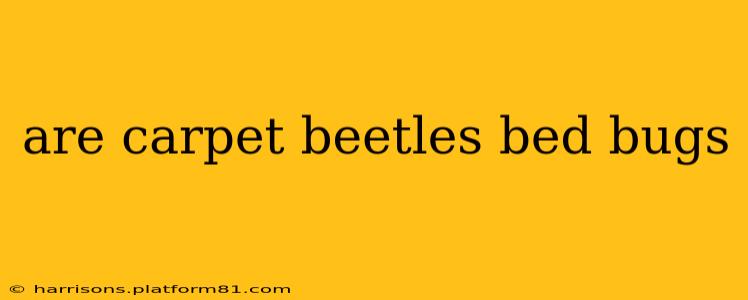Carpet beetles and bed bugs are both tiny insects that can infest homes, causing distress and potential damage. However, despite their similar size and the fact that they both can be found indoors, they are entirely different creatures with distinct characteristics, behaviors, and implications. This article will clarify the differences between carpet beetles and bed bugs, answering common questions and helping you identify the unwelcome guests in your home.
What are Carpet Beetles?
Carpet beetles are small, oval-shaped beetles belonging to the family Dermestidae. They are typically 1/16 to 1/8 inch long and come in a variety of colors, including black, brown, gray, and mottled patterns. Their larvae, which are the most destructive stage, are hairy, elongated grubs with a distinctive dark brown head. Carpet beetles are not known to bite humans, unlike bed bugs. Instead, their larvae feed on natural fibers like wool, silk, cotton, and feathers, causing damage to carpets, upholstery, clothing, and stored items.
What are Bed Bugs?
Bed bugs, on the other hand, are parasitic insects belonging to the family Cimicidae. They are reddish-brown, oval-shaped insects about the size of an apple seed (around ¼ inch long). Unlike carpet beetle larvae, adult bed bugs are wingless and have a flattened body. Bed bugs are notorious for feeding on human blood, causing itchy welts and allergic reactions. They primarily inhabit mattresses, box springs, bedding, and other areas close to sleeping humans.
What are the Key Differences Between Carpet Beetles and Bed Bugs?
Here's a table summarizing the key differences:
| Feature | Carpet Beetles | Bed Bugs |
|---|---|---|
| Size | 1/16 to 1/8 inch | About ¼ inch |
| Appearance | Oval, various colors; larvae are hairy grubs | Reddish-brown, oval, flattened, wingless |
| Diet | Natural fibers (wool, silk, cotton, feathers) | Human blood |
| Bites | No | Yes, causing itchy welts and allergic reactions |
| Habitat | Carpets, upholstery, stored items | Mattresses, bedding, furniture near sleeping areas |
| Damage | Damage to fabrics and stored goods | Skin irritation, allergic reactions |
How Can I Tell If I Have Carpet Beetles or Bed Bugs?
Identifying the infestation requires careful observation. Look for:
- Carpet beetles: Tiny beetles or hairy grubs in carpets, upholstery, or stored items. Check for small holes in fabrics.
- Bed bugs: Small reddish-brown insects in mattresses, bedding, or furniture near sleeping areas. Look for fecal spots (small dark spots) and blood stains on sheets or mattresses. Examine for bite marks on your skin, typically in clusters.
If you are unsure, contacting a pest control professional is always recommended. They have the expertise to identify the pest and recommend effective treatment strategies.
How Do I Get Rid of Carpet Beetles and Bed Bugs?
Treatment methods differ significantly depending on the pest:
- Carpet beetles: Thorough cleaning, vacuuming, and discarding infested items are usually sufficient for minor infestations. Professional pest control may be necessary for severe infestations.
- Bed bugs: Bed bug infestations are notoriously difficult to eliminate and often require professional pest control intervention. Treatments may involve heat treatments, insecticide applications, and encasements for mattresses and box springs.
Do Carpet Beetles Bite?
No, carpet beetles do not bite humans. Their larvae feed on natural fibers, not blood. Any bites you experience are unlikely to be from carpet beetles.
Are Carpet Beetles Harmful?
While carpet beetles don't bite, their larvae can cause significant damage to fabrics and stored goods. This damage can be costly to repair or replace.
Can Bed Bugs Live in Carpets?
While bed bugs prefer areas close to sleeping humans, they can occasionally be found in carpets, particularly if there is clutter or debris providing hiding places. However, they primarily infest bedding and furniture.
This information should help you distinguish between carpet beetles and bed bugs. Remember, early identification and appropriate treatment are crucial for effective pest control. If you're still unsure, seeking professional help is the best course of action.
